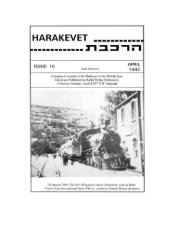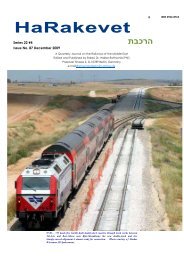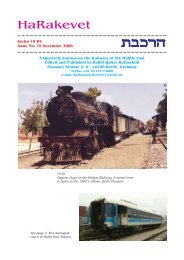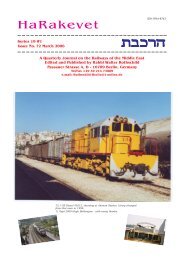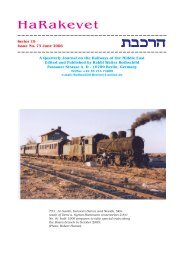Create successful ePaper yourself
Turn your PDF publications into a flip-book with our unique Google optimized e-Paper software.
ived from some association with Hughenden<br />
Manor near Beaconsfield.<br />
From a website concerned with<br />
Disraeli‘s life and writings:- „In the summer of<br />
1833 Disraeli met Sir Francis and Lady Sykes<br />
(d. 1846) and shortly afterwards began an<br />
affair with Henrietta. Sir Francis‘s property included<br />
Basildon Park in Berkshire (now a National<br />
Trust property), a setting for Henrietta<br />
Temple, the novel inspired by the affair and<br />
the pressing need to settle debts. Henrietta<br />
was aristocratic and sensuous and, as the references<br />
to ‚A mother‘s kiss‘ (and ‚your faithful<br />
and fond love‘) indicate, capable of meeting<br />
Disraeli‘s complex emotional needs. Their relationship<br />
was aided by Sir Francis‘s frequent<br />
absences abroad and complicated in the<br />
summer of 1834 by Henrietta introducing Disraeli<br />
to his future mentor, the Lord Chancellor,<br />
Lord Lyndhurst (1772-1863) with whom she<br />
later became involved. But it would be her<br />
affair with Disraeli‘s friend, the painter Daniel<br />
Maclise, which ended their relationship in<br />
December 1836 and subsequently threatened<br />
Disraeli‘s future.<br />
In 1838 Sir Francis sued Maclise for<br />
adultery and, until deterred by his solicitor,<br />
threatened to recover money he claimed had<br />
been improperly paid to Disraeli. It has been<br />
suggested that it was this money that helped<br />
to stave off Disraeli‘s bankruptcy at a critical<br />
time for him. In the Mutilated Diary entry for<br />
1833 Disraeli attributed his ‚happiest year‘ to<br />
being in love with Henrietta, the memories<br />
of this tenderness shaping his last letter to<br />
her in 1837 as her life fell apart. This letter<br />
from Henrietta on [8th]. August 1834 refers<br />
not only to the pain of separation but also to<br />
her pleasure that he is working on the novel,<br />
Henrietta Temple, and to her confidence that<br />
‚it will mend our broken fortune‘. She continues<br />
‚Dearest my tears will blot the paper,<br />
& I cannot restrain them, I know not what I<br />
write‘; not even detailing the latest society<br />
news helped: ‚If you knew how desolate this<br />
[London] house is - your white stick on the<br />
sopha [sic], a ghost of departed joy‘.“<br />
Jim Foy, the General Manager of<br />
Hughenden for the National Trust is sceptical:<br />
„Reading through your e-mail trail below, I<br />
can see that you are referencing the relationship<br />
between Benjamin Disraeli, formerly of<br />
Hughenden Manor, and Lady Henrietta Sykes,<br />
in querying whether George Sykes was involved<br />
with Hughenden Manor at all? This<br />
relationship, as I understand it, commenced<br />
in 1832/3 until 1837 and Benjamin Disraeli did<br />
not purchase Hughenden Manor until 1848,<br />
long after this friendship with Lady Sykes had<br />
ended. Benjamin Disraeli then died in 1881,<br />
some 16 years before Mr George Hughenden<br />
Sykes was born, with the Manor and estate<br />
passing to his nephew Conningsby Disraeli<br />
until 1936 when the estate was held in Trust<br />
by the Abbey family who made Hughenden<br />
Manor over to the National Trust in 1947.<br />
From the information at hand it<br />
would seem that any link between George<br />
Hughenden Sykes and Hughenden Manor is<br />
merely a coincidence and in name alone. If<br />
Mr Sykes is a descendant of the Sykes family,<br />
once of Basildon Park, you could perhaps<br />
contact the team there as we do not hold<br />
any information on this family.“<br />
A genealogical researcher has<br />
come up with quite extensive information<br />
from the British archives, going back several<br />
generations. Not all of this is relevant here.<br />
But we have confirmation that George Henry<br />
Sykes married Frances Riches; on 19th. April<br />
1897 he was a ‚Master Telegraph Engineer‘<br />
and in 1901 his residence was given as<br />
15, Vernon Road, Clapham. George Robert<br />
Hughenden Sykes was their first child, born<br />
19th. April 1897 at 78, Barrington Road, Brixton,<br />
London. He married Doris Clarke on 21st.<br />
Nov. 1928 at the Marylebone Register Office.<br />
Doris had been born 1892 in Greenwich, i.e<br />
was a few years older than he, and she died<br />
1965 in Surrey. So the poor couple had only<br />
some ten months together and there seems<br />
to be no record of her ever having remarried.<br />
At the time she was widowed she was<br />
37 and childless. George‘s death is given as<br />
‚26th. Aug. 1929, Haifa, Palestine.‘ His two<br />
sisters were:<br />
Marie Agnes M. Sykes born 14th.<br />
July 1898 at 78, Barrington Road, Brixton, and<br />
died September 1972 in Thanet; in 1921 she<br />
had married a Henry T. Pockett who died<br />
June 1968 in Thanet; They had a son Raymond<br />
(March 1922) and a daughter Sheilah<br />
(August 1931), the latter died 2002;<br />
and Dorothy Hilda Sykes, born June<br />
1900, Clapham, married Leslie Norman Spear<br />
in March 1931 and had one daughter, Jennifer,<br />
born 1939. So there are indeed some<br />
living descendants of the family, though not<br />
from George‘s direct line.<br />
A rededication of the headstone<br />
for Sykes is now planned for 11.00 on 22nd.<br />
Feb. 2011 at the Haifa cemetery, and anyone<br />
who wishes to attend is welcome. This really<br />
is a quite remarkable story. Kol HaKavod to<br />
Michael.<br />
(g). SELAH MERRILL.<br />
Hanswulf Bloedhorn of Tübingen<br />
has written, in relation to our comments<br />
on the opening of the railway to Jerusalem<br />
with: „one Selah Merill“ and „It is believed<br />
that Selah Merrill was somehow connected<br />
to the American Colony“ that: „S. Merrill<br />
(2nd. May 1837 – 22nd. Jan. 1909) was a<br />
Theologian and studied at Yale as well as,<br />
from 1868–1870, Hebrew in Berlin. As<br />
an Archaeologist I especially value his early<br />
archaeological observations in Syria/Palestine,<br />
where he later served as US Consul<br />
in Jerusalem. Further information on his<br />
life can be found on Wikipedia: .“<br />
(h). RUTENBERG POWER STATION.<br />
In ‚Berliner Zeitung‘ 30/31.10.2010<br />
,cfrv<br />
p. ‚P.1.‘ (Travel supplement) is an article by<br />
Franz Lerchenmüller on tourism in Israel and<br />
Jordan entitled ‚The Way of the Waters‘,<br />
which includes: „As a symbol of the efforts<br />
to make the Jordan into a River of Peace,<br />
a new ‚Peace Patrk‘ is to be opened, on an<br />
island between Jordan and Yarmuk, three<br />
kilometres south of the Lake Tiberias, on<br />
which Israel and Jordan signed their peace<br />
agreement in 1994. In the 1930‘s the Israeli<br />
[sic.!] engineer Pinchas Rutenberg built here<br />
a hydroelectric power station, in agreement<br />
with the King of Jordan. [sic. - at this period<br />
still Transjordan ] From the Israeli side the entrance<br />
only goes to the three bridges constructed<br />
from black basalt, which were built<br />
in the Roman, Ottoman and British periods.<br />
From Jordan the entrance into Israel is possible.<br />
Bent tracks and old barbed wire runs<br />
between the canals, ruins and a crumbling<br />
embankment. Bats fly through the walls of the<br />
former turbine house. But there is no shortage<br />
of fantasies amongst the people here to<br />
make out of this site an attractive Israeli-Jordanian<br />
joint tourism project. The building with<br />
the mighty turbines will become a multi-media<br />
visitor centre. The former houses of the<br />
workers will be converted to Eco-Lodges.<br />
The station in Bauhaus style, a large white hall<br />
with a horseshoe-shaped flat concrete roof<br />
attached, will be revived. The graffiti from<br />
the 1930‘s will stay - „Why is the train late<br />
again?“. Most important though will be the<br />
flat area currently overgrown with bushes.<br />
The former reservoir will be flooded again<br />
and provide a resting place for the 500,000<br />
birds which fly through here annually. Model<br />
for this is the Hula Agamon Lake in the northern<br />
Jordan Valley - a restored area at which<br />
nowadays cranes, storks and pelicans gather,<br />
whilst along the channels beavers fill their<br />
stomachs and show no interest in the tourists,<br />
who travel through the area on electric<br />
cars. And that is how it should also be at<br />
Peace Island - it will involve investment of ten<br />
million dollars, a large portion of good will on<br />
both sides and stable political circumstances<br />
to enable this to become reality.“<br />
(i). OBITUARY - AMITH BEN-SHALOM.<br />
On 22.11.2010 I was shocked and<br />
saddened to learn from Sybil Ehrlich of the<br />
sudden death of Amith Ben-Shalom. She attended<br />
the Levaya (funeral) and notes: „There<br />
were loads of people there, but the only people<br />
from the railfans crowd apart from myself<br />
were Chen, Uri Yinon and Uri Ben-Rehav. The<br />
cemetery is in Moshav Avihayil, on the northern<br />
edge of Netanya. The family has connections<br />
with Moshav Bitan Aharon (I think they<br />
lived there at one time) and Avihayil is the regional<br />
cemetery for the moshavim. It‘s a beautiful,<br />
quiet place, full of trees and tranquillity....<br />
His mother was also there. Amith<br />
was 48 years old, with a wife and children.<br />
People who had been in recent correspondence<br />
with him thought that in the last few<br />
weeks things seemed a bit strange, confused,<br />
not like himself. We asked Amith‘s brother<br />
Page 17



